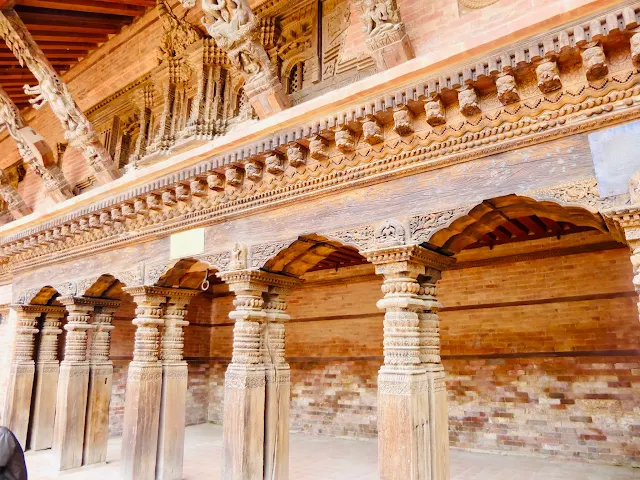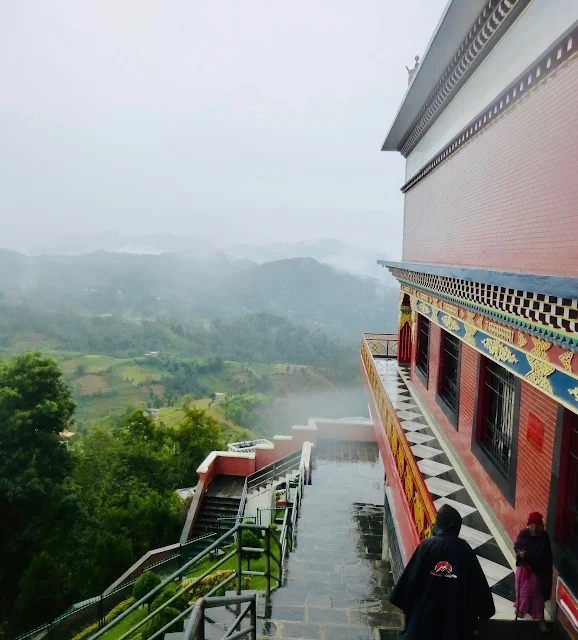Take a look at this one-week travel itinerary for experiencing the wonders of the Kathmandu Valley in Nepal.
Why Travel To Nepal
- Magnificent UNESCO world heritage sites
- Fantastic hiking and adventure activities
- Stunning mountain views
- Diverse culture
- Biodiverse wildlife
- Delicious cuisine
- Friendly locals
- Value for money
Kathmandu Valley Itinerary Map
Kathmandu Valley Travel Itinerary
- Day 1: Arrive in Kathmandu
- Day 2: Explore Kathmandu
- Day 3: Explore Bhaktapur
- Day 4: Nagarkot to Changu Narayan Hike
- Day 5: Explore Patan
- Day 6: Dhulikhel to Namobuddha Hike
- Day 7: Depart
If you've got few more days then consider visiting Pokhra to enjoy stunning scenery and adventure sports.
Best Time To Visit Kathmandu (Nepal)
The best time to visit Nepal is between October and December when the skies are a clear and the views are spectacular. Fall/autumn and spring are the most popular times to visit for hikers, climbers and mountaineers.
Kathmandu Valley Top Experiences
- Atmospheric Boudhanath Stupa
- Historic Bhaktapur and Patan Durbar Square
- Stunning views of the Himalayas from Nagarkot
- Amazing Namobuddha monastery
- Sights, sounds and smells in Kathmandu local markets
Day 1: Arrive In Kathmandu
Kathmandu is the capital and the most populous city of Nepal. It is located in the Kathmandu Valley, which is a large valley in the high plateaus in central Nepal at an altitude of 1,400 meters (4,600 feet).
Best area to stay in Kathmandu: The area of Thamel is the best place to stay in Kathmandu. Thamel is filled with cafes, restaurants, hotels and shopping.
After arriving in Kathmandu settle into your hotel/hostel. It you're not too tired then walk to Kathmandu Durbar Square. It is one of the three Durbar (royal palace) Squares in the Kathmandu Valley, all of which are UNESCO world heritage sites. Durbar Square is an important site for Buddhist/Hindu rituals, royal events, kingly coronations, and holy ceremonies.
In the evening, the tourist hub of Thamel is a good place to grab your dinner.
 |
| Maju Dega (Kathmandu Durbar Square) |
(Above photo by © Vyacheslav Argenberg / http://www.vascoplanet.com/, CC BY 4.0, https://commons.wikimedia.org/w/index.php?curid=103055239)
 |
| Basantapur Tower (Kathmandu Durbar Square) |
Day 2: Explore Kathmandu
- Start your day by visiting Swayambhunath, which is an ancient religious complex atop a hill in the Kathmandu Valley. It is one of the most sacred among Buddhist pilgrimage sites. The complex consists of a stupa, a variety of shrines and temples. The stupa has Buddha's eyes and eyebrows painted on.
- After Swayambhunath visit The National Museum of Nepal which is close by. The museum has interesting collection of Nepalese paintings, murals, statues, weapons, plants, etc.
- After having a nice lunch in the afternoon visit Boudhanath Stupa. It is one of the largest stupas in the world and an UNESCO world heritage site. Try to spend some time around the stupa soaking in the captivating surroundings and the spiritual atmosphere. Also consider coming to Boudhanath in the evening when is it very atmospheric under the lights.
 |
| Swayambhunath Stupa (Kathmandu) |
(Above photo by Nabin K. Sapkota - Own work, CC BY-SA 4.0, https://commons.wikimedia.org/w/index.php?curid=73238737)
 |
| Swayambhunath (Kathmandu) |
 |
| National Museum of Nepal (Kathmandu) |
 |
| Boudhanath (Kathmandu) |
Day 3: Explore Bhaktapur
- After a nice morning breakfast, travel to Bhaktapur which is another one of the main cities of the Kathmandu Valley and is about 13 km from Kathmandu. Bhaktapur is a major Newar settlement of the country and is known for its Newari tradition, cuisine and artisans.
- Start your exploration at Bhaktapur Durbar Square which is a former royal palace complex. It housed the kings of Nepal from 14th to late 18th century.
- Next visit the Taumadhi Square, which houses the tallest pagoda styled temple of Nepal (Nyatapola Temple), and also houses several other temples.
- Then visit the Pottery Square close by, which is filled with potter's wheels and numerous sun-dried clay pots. After visiting the Pottery Square you can enjoy nice Nepali lunch and tea at one of the restaurants near the square.
- Once back into the Kathmandu city in late afternoon, talk a stroll and relax at the Garden of Dreams which is a neo-classical garden.
 |
| Garden Of Dreams (Kathmandu) |
Day 4: Nagarkot and Changu Narayan
Take a break from the cultural and heritage sites of the Kathmandu Valley and travel to Nagarkot in morning, which is located 32 km from Kathmandu. Nagarkot is at an elevation of 2,195 meters and commands one of the broadest views of the Himalayas in the Kathmandu Valley. Nagarkot also offers a panoramic view of the Kathmandu Valley.
The scenic beauty of the place makes it a very popular for hiking. Consider doing a day hike with a guide who can drive you to Nagarkot for the views and then also take you on the famous trail from Nagarkot to Changu Narayan. Along the way while hiking you'll enjoy village life, local culture, and stunning mountain views. The hike ends at the lovely Changu Narayan Temple which is an ancient Hindu temple and an UNESCO world heritage site.
 |
| View of Himalayas from Nagarkot |
 |
| Changu Narayan Temple |
 |
| Changu Narayan Village |
Day 5: Explore Patan (Lalitpur)
- Start your day by travelling to Patan which is another one of the main cities of the Kathmandu Valley. It is best known for its rich cultural heritage, particularly its tradition of arts and crafts.
- Start your exploration at Patan Durbar Square which is UNESCO world heritage site and was the ancient royal palace where the Malla Kings of Lalitpur resided. There are many temples and statues in the area.
- After the Darbar Square visit the Patan Museum which displays the traditional sacred arts of Nepal and is located inside an old residential court of Patan Durbar (palace).
- In the afternoon return back to the Kathmandu city and visit Pashupatinath Temple, which is a Hindu temple dedicated to Lord Shiva. The temple complex is collection of temples, ashrams, inscriptions, etc. along the banks of the sacred Bagmati river.
 |
| Patan Durbar Square |
 |
| Patan Durbar Square |
 |
| Patan Durbar Square |
 |
| Patan Durbar Square |
 |
| Patan Musuem |
Day 6: Dhulikhel and Namobuddha
Travel to Dhulikhel in morning which is located 30 km from Kathmandu. Dhulikhel also provides amazing views of the Himalayan ranges. Consider doing a day hike with a guide who can drive you to Dhulikhel and also take you on the trail from Dhulikhel to Namobuddha. Along the way while hiking you'll enjoy village life, local culture, temples and stunning mountain views. The hike is approximately 10 kms and takes around 4 hours. The hike will end at the beautiful Namobuddha Monastery (Thrangu Tashi Yangtse Monastery).
 |
| Namobuddha Monastery |
(Above monastery photo by simpl3punk - Own work, CC BY-SA 4.0, https://commons.wikimedia.org/w/index.php?curid=58808351)
 |
| View from Namobuddha Monastery |
Day 7: Kathmandu
This being your last day in Kathmandu Valley, spend time doing last minute shopping in Thamel. Then depart to your destination from Kathmandu.
.jpg) |
| Thamel (Kathmandu) |
(Above Thamel photo by Raimond Klavins on Unsplash)
What to Shop In Nepal
Nepal is known for Pashmina shawls, singing bowls, rice paper products, handicrafts, jewelry, and Thangka paintings.
I’d love to hear your thoughts on this itinerary! Feel free to share your questions or suggestions in the comments section below.














.jpg)









No comments:
Post a Comment